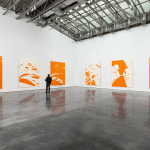Shelly Bancroft and Peter Nesbett are reopening Triple Candie this month at 148th Street, just west of Amsterdam. At ArtInfo, Chris Bors sits down with the husband-and-wife team, who are also the co-publishers of Art on Paper, to discuss the future of Triple Candie and its controversial past. “In 2006 the gallery took a provocative new direction when it decided to present two exhibitions consisting of re-creations of artworks by well-known artists mounted without their permission.
“David Hammons: The Unauthorized Retrospective,” consisting of photocopies of the artist’s work from Web sites, catalogs, and brochures, was followed by “Cady Noland Approximately,” a fake survey of the notoriously reclusive artist’s oeuvre that used copies of her work made by Triple Candie and four other artists. Noland —who had stated that she doesn’t want her work shown in public and asked galleries to remove it from shows — garnered a great deal of sympathy as a result of the project, including from such critics as the Village Voice’s Jerry Saltz, who suggested that she sue the gallery. “Indeed, many have had similar reactions to Bancroft and Nesbett’s strategy of forgoing artists in creating their exhibitions, but one thing can’t be denied: The two have made a bold statement that at the very least deserves considered analysis. Rather than cheerleading for artists and boosting careers, Triple Candie has taken the lonelier path of challenging the art world by turning tradition on its head.
“What is the first exhibition?
We are opening with an exhibition of floral still-life “paintings” that we bought at El Mundo, a big economy department store around the corner from the new Triple Candie. The paintings are sold as anonymous objects without authors, dates, or histories. In fact, they are reproductions of lesser-known Old Master paintings that somewhere in the distribution channel — between China and Harlem — lost their identities. In that way, the exhibition will tie into our “Anonymous Artist Projects” from 2004 and 2005. “Our second show will be a Picasso retrospective that doesn’t include any real Picassos. That would be impossible to realize in Harlem; probably only MoMA and a few high-end commercial galleries could organize it. We’re going to create surrogates of the Picasso artworks, probably large pieces of cardboard cut to the scale of the actual paintings with a small reproduction taped to each. To anyone visiting the gallery, it will look like an exhibition in the midst of being installed — the moment right before the artwork arrives. We will be waiting for it to arrive for the entire show.
“You have created shows that you call ‘exhibitions about art that are devoid of artwork.’ What do you hope to gain by tweaking the established exhibition models of most spaces?
Our program is decidedly anti-material and anti-market. We are very much against the fixation and fetishization of the object. These are meant to be ephemeral exhibitions, and we recycle most of the material from show to show. It’s fundamentally about this sort of fleeting temporary experience dealing with issues of art history. A lot of our shows were realized when the art market was going through unprecedented growth. The greed that we saw in the art world was coupled with the greed that we were seeing in society at large, so we tried to do shows that shifted the emphasis. Because we saw artists as complicit with the problems we were seeing, we were motivated not to work with them.”
Read more.






















